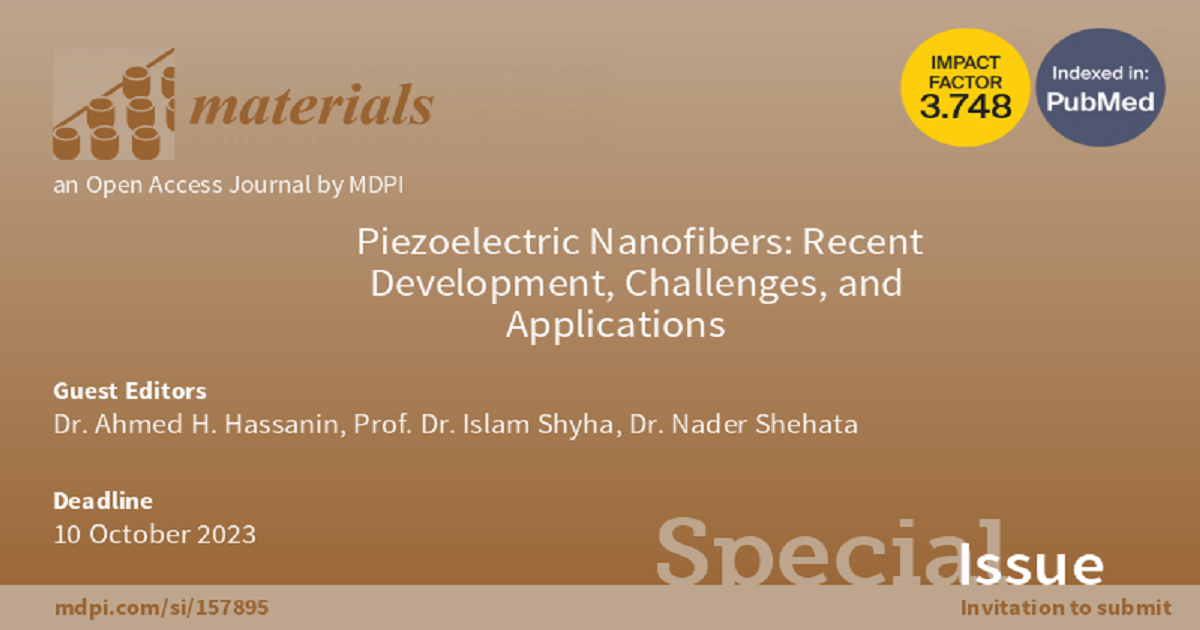- 3.2Impact Factor
- 6.4CiteScore
- 16 daysTime to First Decision
Piezoelectric Nanofibers: Recent Development, Challenges, and Applications
This special issue belongs to the section “Smart Materials“.
Special Issue Information
Dear Colleagues,
Piezoelectric membranes have been extensively investigated over the last two decades in applications of energy harvesting, smart home, efficient lighting, and wearable electronics. Polymeric nanofibers membranes have sparked an increased interest in both research and applications due to their flexibility, higher surface-to-volume ratio, and low cost. However, due to their limited transducing efficiency compared to bulky ceramics and relatively lower-scale production, there are various challenges to using such nanocomposites on a wide range of applications. Therefore, the goal of this Special Issue is to attract the most prestigious research publications on recent techniques for improving the mechanical-to-electrical transducing efficiency of nanofiber membranes. These techniques include, but are not limited to, the use of higher-performance polarized polymers, promising additives to enhance polarizability, fabrication techniques to improve the piezoelectric performance, along with different applications of developed nanofibers mats in sensors, transducers, vibration detection, acoustic harvesting, wearable electronics, and more. Review articles are also welcome, but should focus on recent trends in the field’s literature.
Dr. Ahmed H. Hassanin
Prof. Dr. Islam Shyha
Dr. Nader Shehata
Guest Editors
Manuscript Submission Information
Manuscripts should be submitted online at www.mdpi.com by registering and logging in to this website. Once you are registered, click here to go to the submission form. Manuscripts can be submitted until the deadline. All submissions that pass pre-check are peer-reviewed. Accepted papers will be published continuously in the journal (as soon as accepted) and will be listed together on the special issue website. Research articles, review articles as well as short communications are invited. For planned papers, a title and short abstract (about 250 words) can be sent to the Editorial Office for assessment.
Submitted manuscripts should not have been published previously, nor be under consideration for publication elsewhere (except conference proceedings papers). All manuscripts are thoroughly refereed through a single-blind peer-review process. A guide for authors and other relevant information for submission of manuscripts is available on the Instructions for Authors page. Materials is an international peer-reviewed open access semimonthly journal published by MDPI.
Please visit the Instructions for Authors page before submitting a manuscript. The Article Processing Charge (APC) for publication in this open access journal is 2600 CHF (Swiss Francs). Submitted papers should be well formatted and use good English. Authors may use MDPI's English editing service prior to publication or during author revisions.
Keywords
- piezoelectric
- nanofibers
- polarization
- energy harvesting
- transducer, sensor

Benefits of Publishing in a Special Issue
- Ease of navigation: Grouping papers by topic helps scholars navigate broad scope journals more efficiently.
- Greater discoverability: Special Issues support the reach and impact of scientific research. Articles in Special Issues are more discoverable and cited more frequently.
- Expansion of research network: Special Issues facilitate connections among authors, fostering scientific collaborations.
- External promotion: Articles in Special Issues are often promoted through the journal's social media, increasing their visibility.
- e-Book format: Special Issues with more than 10 articles can be published as dedicated e-books, ensuring wide and rapid dissemination.

